Over the past year, we’ve been covering the transition of 5% Nutrition’s supplements to their white “Legendary” labeling series. This included the ALL DAY YOU MAY amino acid feeder, the Kill it Reloaded pre-workout, and most recently, the Mentality energy nootropic.
Now it’s time to update an article from 2015, when we first detailed Rich Piana’s already-legendary creatine supplement: Crea-TEN. It’s now updated with the white labeling, but still has the same epic creatine strategy:
TEN forms of creatine?! Yes.
That’s right – this is the Rich Piana way. When the industry’s most prominent renaissance man of the 2010s put out a creatine supplement, he wanted something different, and something that could be used by those who don’t have great results with creatine monohydrate alone.
Rich and his team came up with the most creative creatine supplement to date: Crea-TEN, which included ten effective forms of creatine (totaling 5 grams) and a creatine acceleration blend to get it where you need it to go – into muscle tissue to generate more ATP.
This is also one of the few products to utilize creatine pyruvate, an underrated form that we’ve recently become excited about.
The formula is detailed below, but first check all of the deals and flavors available through PricePlow:
Rich Piana 5% Nutrition Crea-TEN – Deals and Price Drop Alerts
Get Price Alerts
No spam, no scams.
Disclosure: PricePlow relies on pricing from stores with which we have a business relationship. We work hard to keep pricing current, but you may find a better offer.
Posts are sponsored in part by the retailers and/or brands listed on this page.
The benefits of creatine
Before getting into the details, we should briefly cover many of the studies that have been conducted on creatine over the years. What was once “controversial” in the late 1990s is now simply taken for granted: creatine works wonderfully and is incredibly safe.
It’s all about ATP
First, the mechanism: creatine works by providing a critically-needed phosphate group to help your body produce more cellular energy. The adenosine diphosphate (ADP) molecule takes the added phosphate and makes it into adenosine triphosphate (which is also known as ATP)[1-4] — ATP is the main “currency of energy” for our cells. Our cells care about ATP, not calories, and creatine makes it easier for us to produce more ATP.
When you’re low on ATP, or unable to produce it, performance and energy are greatly diminished. Without creatine taken through diet (mainly meat) or supplementation, the body must go through costly and energy-consuming processes to make more.[5]
The broad implications of the above mechanism explain why creatine’s benefits are so wide-ranging, going far beyond muscle building and athletic performance (although that’s the primary focus of this article):
Creatine benefits
There’s so much research available that many of the effects have been verified through rigorous meta-analyses:
- Improved muscle power[6,7]
- Weight gain[7]
- Lean mass gains[7-11]
- Better sprint speed,[12-14]
- Reduced fatigue,[15-18]
- Improved hydration,[19]
- Improved overall well-being[20-22]
- Increased brain function (mainly in vegetarians)[23,24]
Creatine is one of the numerous compounds (alongside carnitine, choline, and various active vitamins and minerals) that vegan and vegetarian diets are missing, causing their diminished performance, virility, mood, and cognitive function.
While supplementing creatine is great, we should really cover its natural sources and then see how much we should supplement:
Food sources of creatine
Long story short, creatine is found in meat, generally muscle meat. If you want to build muscle, you need to eat muscle — there’s more than just protein in there. Beef is the best source, with about 2-2.5 grams per uncooked pound,[25,26] while chicken has about 1.5 grams per pound.[27]
This is why the original black tubs of Crea-TEN had an image of Rich Piana eating a massive raw steak!
How much creatine to get?
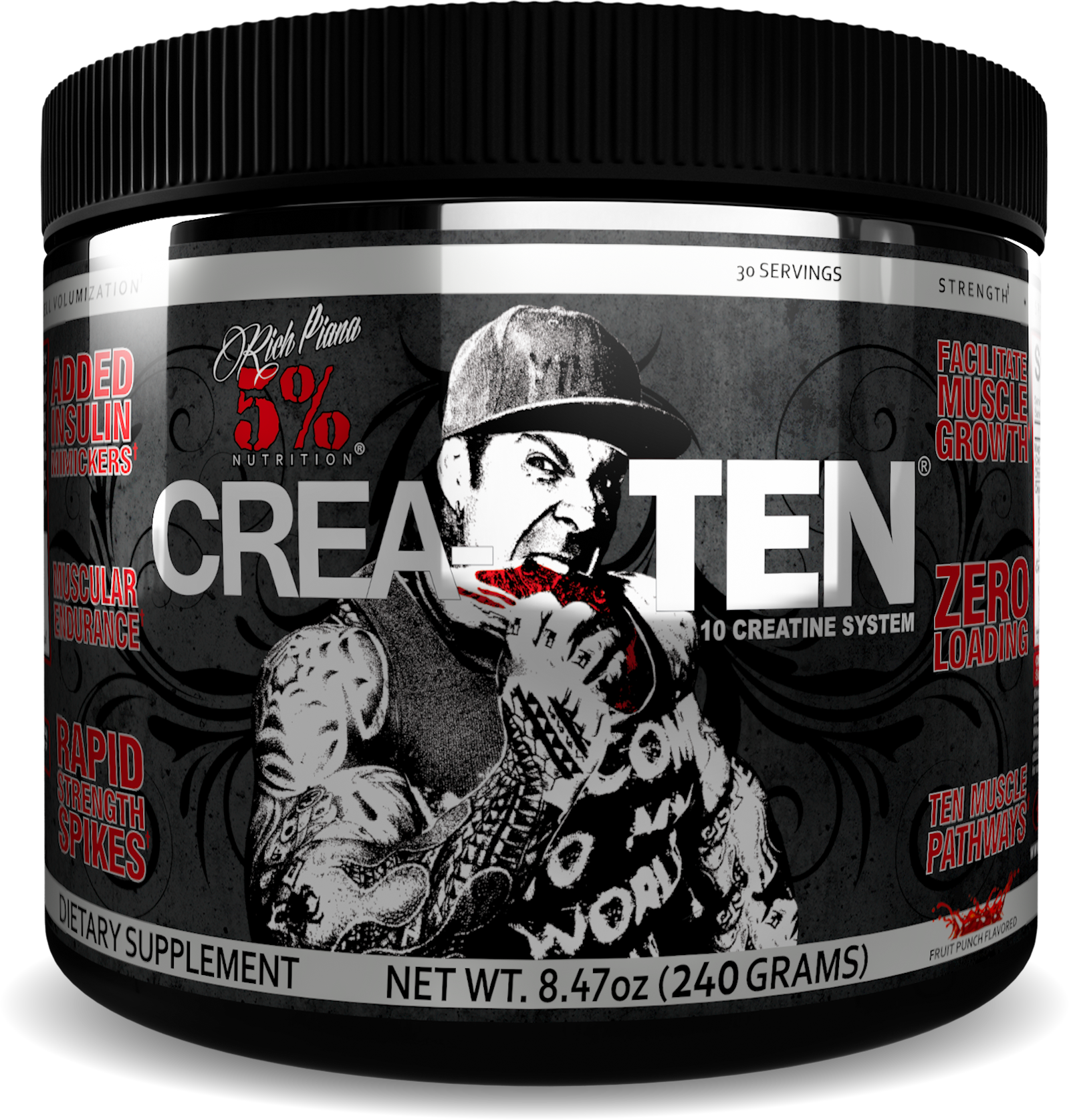
There’s a reason why the original Crea-TEN tubs showed Rich eating a raw steak: creatine is found in copious amounts in red meat!
However, simply taking 2 grams per day may not get you to saturation or into athletic performance potential, which is why 3-5 grams per day has become the key dosage that covers nearly any dieter and athlete size. Rich Piana, of course, chose 5 grams.
We’ve gone on the record stating that we consider creatine to be an essential vitamin – we need to maintain levels and keep them high, and would generally consider 3 grams to be our “100%”. Unsurprisingly, 5% Nutrition goes above that.
Now let’s get into Crea-TEN:
5% Nutrition Crea-TEN Ingredients
-
Creatine Blend – 5,000mg
Here come the ten forms:
-
Creatine anhydrous
Everyone talks about the ten forms of creatine, but don’t miss out on the incredible creatine accelerate blend to drive it into the muscle tissue!
If you’re looking for the most dense creatine on the market, you’ve found it: creatine anhydrous is merely creatine without water. Creatine anhydrous is 100% creatine by weight (whereas creatine monohydrate is 88% creatine by weight due to its attached molecule of water).
This is a great thing to see as the first ingredient in a blend – one concern with alternative forms of creatine is that “5 grams is not 5 grams of creatine“. We’re not as concerned about that since most studies do great with 3-5 grams of creatine monohydrate (which is really 2.64 – 4.4 grams of actual creatine if being absolutely precise), but creatine anhydrous avoids the discussion completely. Good to see up first.
-
Tricreatine Malate
Tricreatine malate is three creatine molecules bonded with malic acid, not unlike the bonding used to manufacture dicaffeine malate found in 5% Nutrition’s Mentality. It’s sometimes simply known as creatine malate, but we prefer the appropriate nomenclature Rich Piana (a better chemist than some of the researchers we see getting published these days) used here.
Malic acid is part of the Krebs cycle, assisting in basic energy metabolism that we allude to in the above area discussion ATP, and may have endurance benefits of its own.[31] This is why we’re often happy to see sour flavored supplements that have extra malic acid inside – the ingredient that makes it sour may also be used in our energy production process!
Tricreatine malate has been specifically used to improve sprint speed.[32] This form also has improved solubility, and may help the solution in water. The bond is strong enough to prevent the body’s early conversion to creatinine.[33]
-
Creatine Monohydrate
The gold standard of creatine supplementation, creatine monohydrate is the basis of the majority of research studies cited in our creatine benefits section. When in doubt, creatine monohydrate or creatine anhydrous are the places to start.
Creatine monohydrate is simply creatine with a water molecule attached – it’s 88% creatine by weight. Some claim that this water may cause added water weight, and some theorize that it may be so osmotically active that the creatine we don’t use pulls water into the colon, but none of this has been backed by research.
The point is, creatine is the most studied and trusted form, but it’s not everyone’s favorite form. Putting it third in the label makes good sense.
-
Tricreatine Citrate
Similar to tricreatine malate, we have tricreatine citrate, which is instead bonded to citric acid – another key component in the Krebs cycle (which is actually also known as the citric acid cycle). It has about the same absorption and kinetic speed as creatine monohydrate,[34] but is more water soluble than monohydrate,[35] helping Crea-TEN mix better in your shaker cup (or gallon jug).
There are different ratios of creatine citrates available: creatine citrate is a 1:1 ratio, dicreatine citrate is a 2:1 ratio, and tricreatine citrate is a 3:1 ratio. Leave it to Rich to give us the most creatine per gram of material.
-
Creatine Pyruvate
Creatine Pyruvate showed higher bioavailability and led to more creatine in plasma than both creatine monohydrate and creatine citrate at the same dose![34]
Now it’s time for the creatine we’ve become excited about – creatine pyruvate, which is creatine bound to pyruvic acid. As a key part of the TCA cycle, pyruvate is very important in the ATP production process.[36]
But more importantly, creatine pyruvate has been shown to have greater bioavailability than creatine citrate and creatine monohydrate![34] Additionally, it can increase mean power better than alternative forms as well.[37] As it stands right now, we consider creatine pyruvate to be the most underrated form of creatine, and Crea-TEN is one of the few places where you can get it in.
Going further, we’ve even seen high-dose pyruvate supplementation boost endurance.[38,39] We won’t have enough here to make those claims, but this is a molecule that’s great to have around.
-
Creatine Ethyl Ester Hydrochloride
Creatine Ethyl Ester (CEE) was big for a while, when some users were looking for monohydrate alternatives that can bypass creatine transporters — it may be useful for rare conditions when creatine transporters are deficient or downregulated.[40,41]
CEE is 82.4% creatine by weight,[34] and most studies have shown creatine monohydrate to outperform it.[42] The ingredient also tastes like battery acid, so we’re happy it’s towards the lower end of the list.
-
Creatine Alpha-Ketoglutaric Acid
Known as creatine AKG, creatine alpha-ketoglutaric acid could be helpful in the Krebs cycle in a manner similar to the pyruvate from creatine pyruvate. It’s theoretically claimed to have an increased absorption rate, but we haven’t seen that in research. Creatine AKG is only 53.8% creatine by weight,[34] so it’s also good to see lower on the list.
-
Creatine Gluconate
Can’t complain about this – creatine gluconate is creatine bound to a glucose molecule, adding a smidge of sugar to your creatine. This one will help flavor, although it doesn’t have much specific research.
-
Creatine Phosphate
Our final form in Crea-TEN, creatine phosphate is actually a naturally-found creatine that is used to store phosphate in tissue.[43] You may also see it written as phosphocreatine. By binding it to an extra phosphate group (which creatine already provides), it may provide even more cellular energy than most forms of creatine. Alongside creatine pyruvate and creatine gluconate, this is perhaps the third type of creatine that deserves more research in terms of supplementation.
-
-
Creatine Accelerate Blend – 1,580 mg
In their best effort to get the most out of this ensemble cast, 5% Nutrition includes a Creatine Accelerate Blend (1590mg) aimed towards maximum absorption.
-
Taurine
LEGENDARY Status: 5% Nutrition’s All Day You May is moving to the white tub, but the formula is mostly unchanged. See how Rich Piana shattered the industry with this supplement, especially with that Southern Sweet Tea flavor!
We’ve covered the great osmolyte taurine in numerous articles, especially in ALL DAY YOU MAY. It’s here for its cell volumization purposes, as it increases cellular hydration. This can leads to all kinds of endurance gains which may be experienced on the first use![44]
-
Betaine Anhydrous
The combination of betaine and creatine is a growing trend, as is betaine and taurine. Whereas creatine is a phosphate donor, betaine is a methyl donor[45,46] (its name is also trimethylglycine). This leads to an insane number of health and athletic benefits, but we want to be cautious here since many of the studies used at least 2.5 grams per day, which we won’t have in here.
-
Gymnema Sylvestre Extract
Gymnema has been used to lower blood sugar levels by raising pancreas insulin response. Raising the insulin response allows for increased nutrient uptake – functioning to get the creatine (and other nutrients) in muscle tissue!
If you’re interested in this type of effect, you must see Rich Piana’s FREAK SHOW glucose disposal agent supplement, which has a full gram of gymnema in a day’s use… and get ready to carb up!
-
Banaba (Lagerstroemia speciosa) (Leaf)
Similar to gymnema, banaba is also in the Freak Show GDA and is used to activate the muscle tissue’s GLUT4 receptors in an effort to drive more glycogen to them. Higher doses have been shown to reduce blood sugar after eating.
-
Fenugreek Seed Extract
Love carbs and need to drive them home? Then join the FREAK SHOW
Fenugreek gained a reputation as a natural testosterone booster, and is rich with a number of micronutrients including 4-hydroxyisoleucine. This particular amino acid aids in blood sugar management, with a similar strategy to that of gymnema and banaba.
-
BioPerine
Standardized for piperine, the black pepper extract named BioPerine is used to increase absorption of ingredients and delay their breakdown. This may actually work better with the rest of the creatine accelerate blend than the creatine itself!
-
Chromium – 343% DV
In addition, don’t miss the chromium provided from chromium chloride that’s in the nutrition area at the top of the label. Chromium is a critical essential nutrient to help with proper insulin signaling, which is necessary for our goals here.
-
Flavors available
How to take Crea-TEN
Typically, you can take creatine any time of the day. Some people like it first thing in the morning, others like it post workout, and still others just get it into their pre workout. It doesn’t matter, just do what works best for you on a regular basis.
With the creatine accelerate blend providing a good bit of glucose disposal support, you could also consider taking this before a carbohydrate-containing meal – it may work very well in a post-workout state before crushing your post workout carbs.
If you eat enough meat and are on a budget, you can take an “underwhelming scoop” to save some money and make that tub last longer… but for most 5-Percenters, you’ll want to full scoop this bad boy.
Crea-TEN is a Rich Piana Classic

The man’s legendary status would have persevered regardless, but 5% Nutrition is keeping the classics where they belong
We’ve always loved Crea-TEN, if for no other reason that Rich Piana educated us about creatine pyruvate with it. The discussion is similar to the one we recently had regarding Kill It in our article on the Kill It Push Pop flavor: yes, it’s a proprietary blend, but it’s one that we wouldn’t mess with. Reason being, this was a classic Rich Piana supplement, and we don’t want 5% Nutrition to tinker with the late legend’s vision.
Besides, we’re getting five grams of creatine ingredients – and that’s what truly matters. Everything else is icing on the cake. Overall, we’d still suggest finding a way to get more betaine into your day, and that can be done with Kill It Reloaded, and then you’re off to the races.
So to answer the introductory question, ten forms of creatine?! The answer is yes: Crea-TEN is Classic Rich Piana and it has to stay that way.
Rich Piana 5% Nutrition Crea-TEN – Deals and Price Drop Alerts
Get Price Alerts
No spam, no scams.
Disclosure: PricePlow relies on pricing from stores with which we have a business relationship. We work hard to keep pricing current, but you may find a better offer.
Posts are sponsored in part by the retailers and/or brands listed on this page.
Note: This article was originally published on March 20, 2015, and updated on December 23, 2021. What a wild ride it’s been.



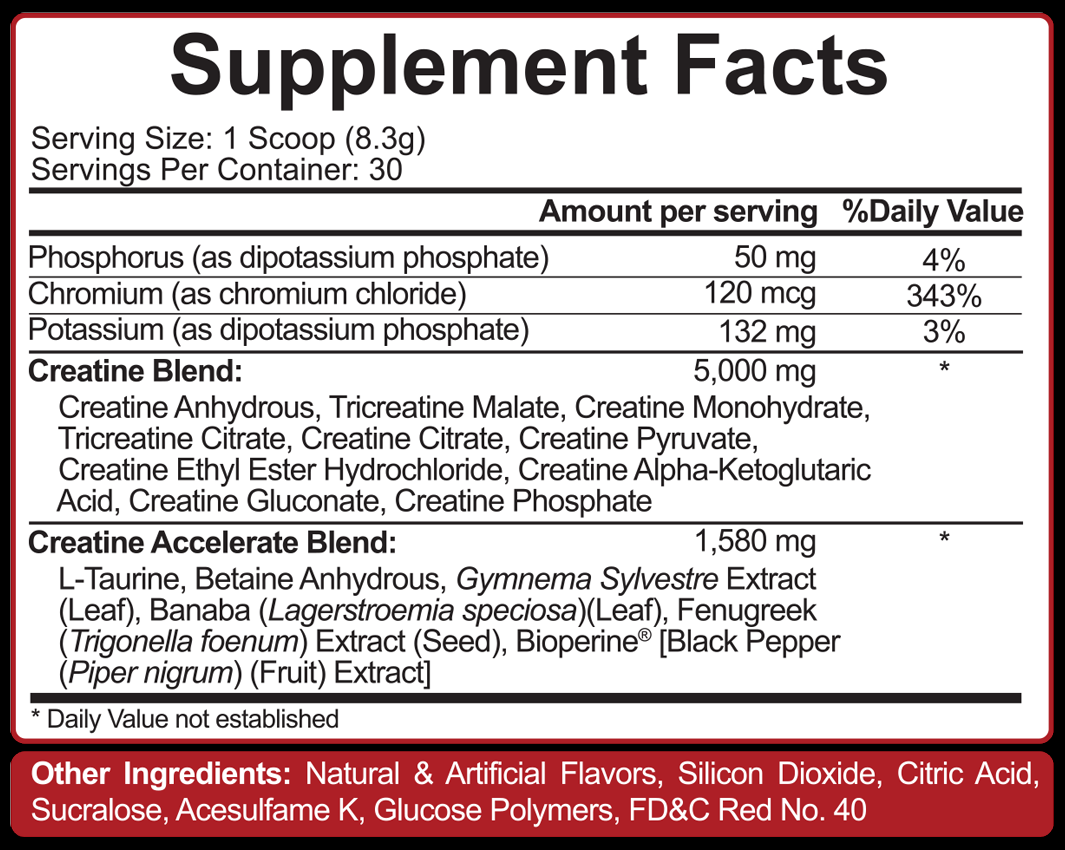


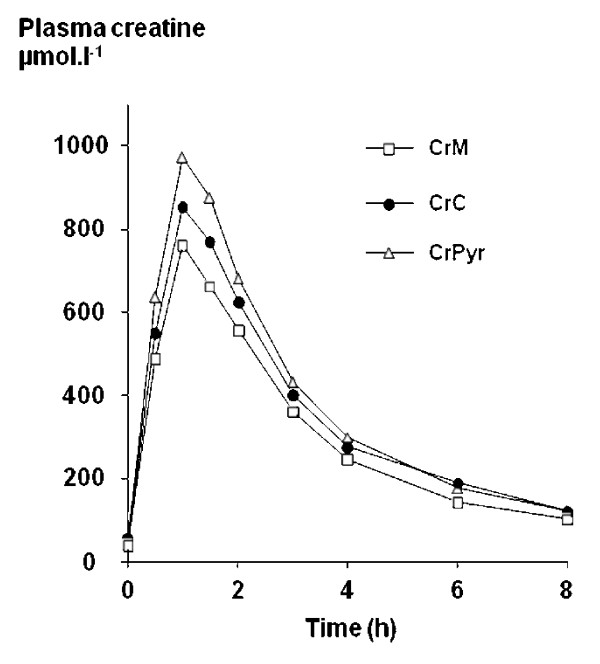
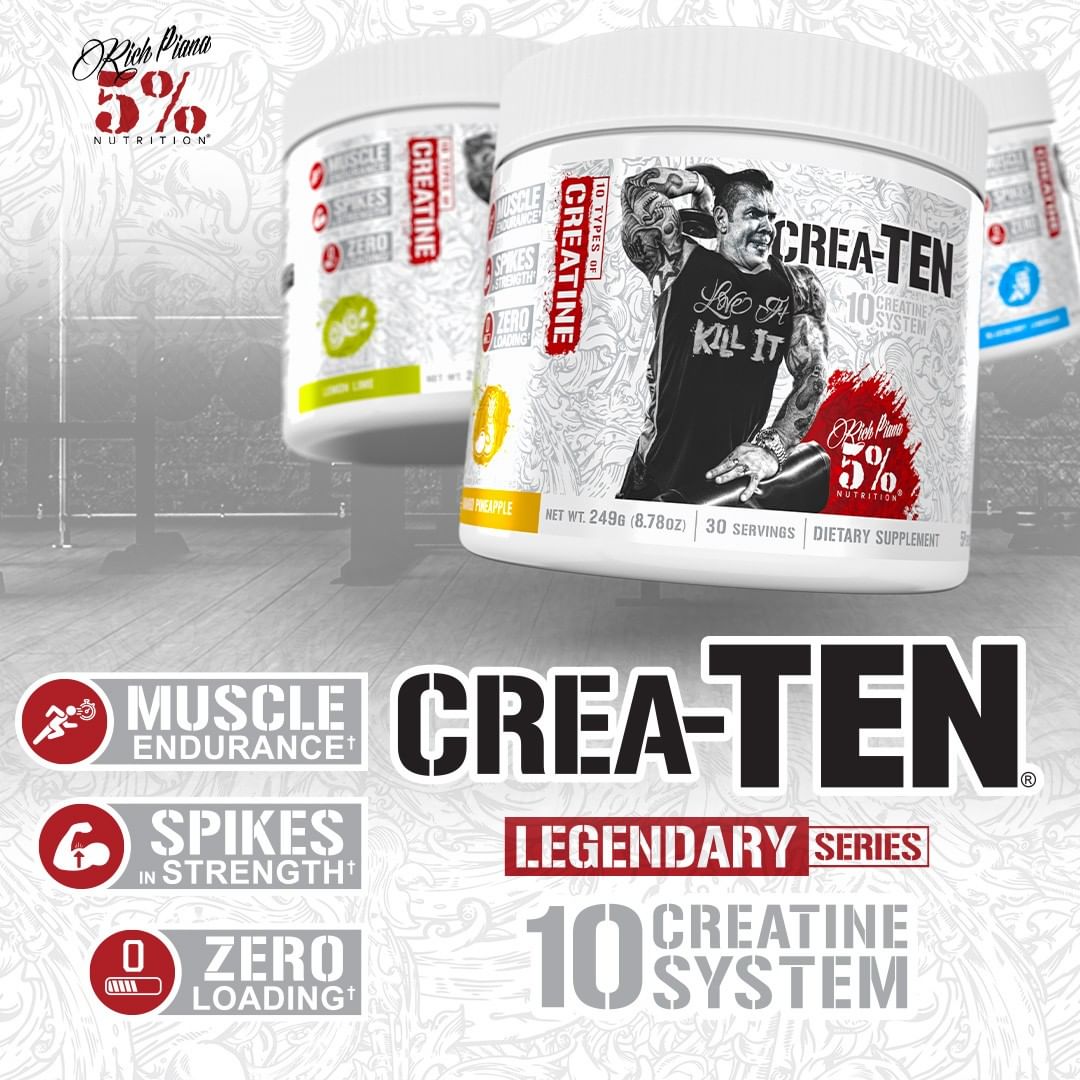





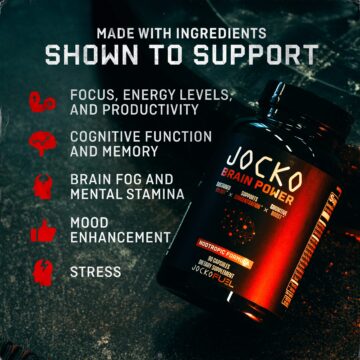
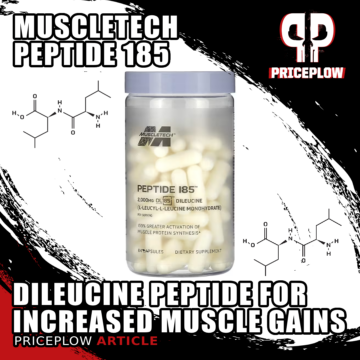
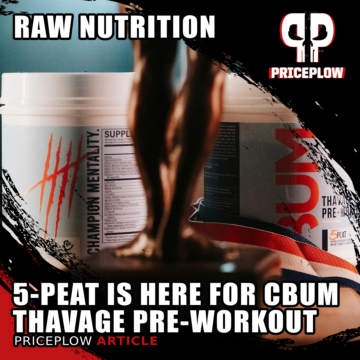
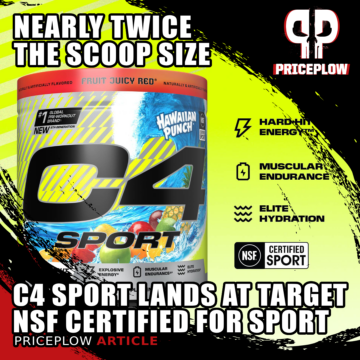

Comments and Discussion (Powered by the PricePlow Forum)